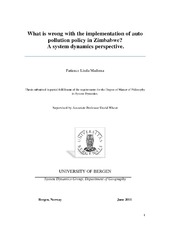| dc.description.abstract | Zimbabwe has in recent years experienced rapid growth in the national vehicle population. Since 1994, the vehicle population has increased by a total of over 150%. Many of these are poorly maintained low-cost second hand vehicles that do not meet strict emission standards of the countries of their origin. Zimbabwe has become a dumping ground for used cars because people rely heavily on importing second-hand vehicles as they cannot afford new vehicles sold in the country. As a result vehicle emissions have remained prevalent and have become a major source of pollution in the country's urban cities. In 2002 an Environmental Management Act was introduced which replaced the old environmental policies. The policy prohibits pollution from vehicles and to ensure this, the Act created an Environmental Management Agency (EMA) which appoints a Standards and Enforcement Committee responsible for monitoring air quality standards through stationery monitoring which focuses on industrial emissions from factories and mobile monitoring for vehicles. However, despite clear intentions and regulations, implementation of the Act has remained minimal as literally no action was taken since the inception of the Act to this date to monitor and control mobile emissions. We therefore seek to address issues on what could have gone wrong with the implementation and what we could do to improve the process. Auto pollution is expected to keep rising as cheap cars flood the market rendering the Environmental Management Act ineffective. System dynamics simulation and policy implementation analysis are used to answer the research question. The study designs a model that links auto pollution in Zimbabwe and the flow of sub-standard cars into the country, the duration of their use in Zimbabwe and the resulting effect as compared to the use of new cars sold in the country. It analyzes the current policy and develops options for improvement of the same policy. | en_US |
